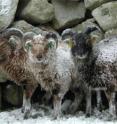Old sheep raising the baaa
Populations of wild animals face the challenge of surviving in a changing climate. Researchers at Imperial College London and Université Claude Bernard Lyon have shown how a sheep population on a remote island off the west coast of Scotland responds to two consequences of climate change: altered food availability and the unpredictability of winter storms. Dr. Thomas Ezard, lead author of the study, revealed, "When times are good and food is plentiful, lambs contribute almost twice as much to changes in population size than when times are hard. On the flip side, the oldest sheep contribute most to population growth when conditions are harsh." The work, published in the September issue of The American Naturalist, suggests that the dynamics of populations are influenced not only by the weather but also by the ability of individuals to respond to it. New mathematical breakthroughs have made it possible to show how environmental change affects populations, like these sheep. The key is appreciating (1) how weather affects individual sheep and (2) how the weather changes from one year to the next. If consecutive years have similar weather, the dynamics of the population will be very different than if conditions are unrelated from one year to the next. Professor Tim Coulson concluded, "A thorough understanding of the likely effects of climate change on the ecology of wild populations requires linking populations to their environment. This demands application of innovative mathematical methods, as used here."
Source: University of Chicago Press Journals
Other sources
- Oldest Sheep Contribute Most To Population Growth When Climate Changes Making Conditions Harshfrom Science DailyFri, 5 Sep 2008, 21:14:05 UTC
- Old sheep raising the baaafrom PhysorgFri, 5 Sep 2008, 17:49:07 UTC
